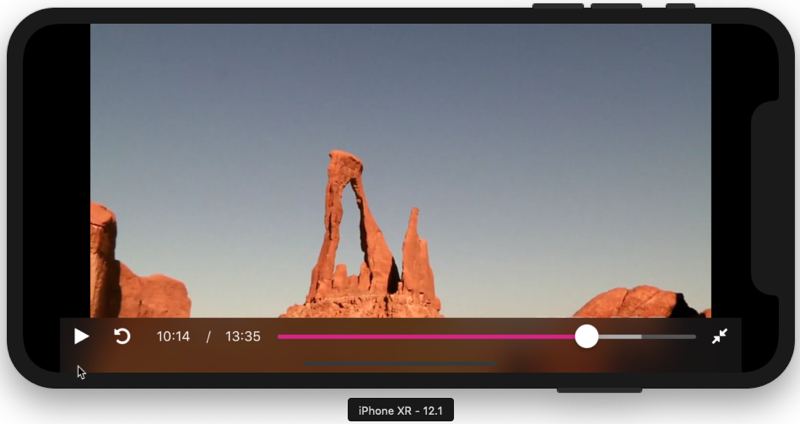Overview
This example plays a video returned from the Brightcove Playback API, which is the latest and recommended API to retrieve content from your Video Cloud library.
For this option, you will need a Policy Key. If you are not familiar with Policy Keys, see Policy API Overview.
Get started
This example plays videos from an internal array of video files.
Follow the steps below to get familiar with setting up an app project that uses the Brightcove Player SDK for iOS. You can view the complete code for each of the following:
There are two ways to try out this sample:
Download the sample
Download the entire Xcode project for experimentation.
- Clone or download the Native SDK for iOS samples to your local system.
- Navigate to the Player/VideoCloudBasicPlayer/swift sample app.
- Run the
pod installcommand. - Open and run the newly created workspace.
For details, see the Running Sample Apps for the Native SDK for iOS/tvOS document.
Build the app by following the steps in this guide
Follow the steps below to get familiar with setting up an app project that uses the Brightcove Player SDK for tvOS. You can view the complete code for each of the following:
Create the project
Set up a project in Xcode. Then add the SDK along with any dependencies to the project.
Set up the Xcode project
Create a new Xcode project for the app.
-
Start the creation of a new iOS project in Xcode. Select Create a new Xcode project.
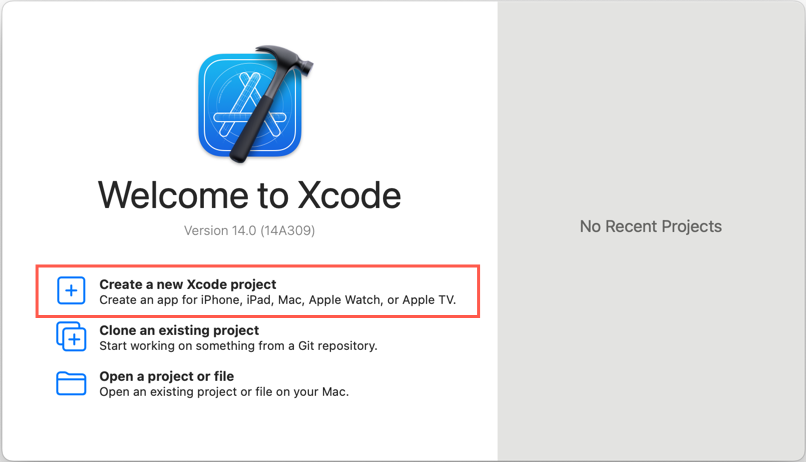
Create project -
Select iOS and Single View Application for your new project. Select Next.
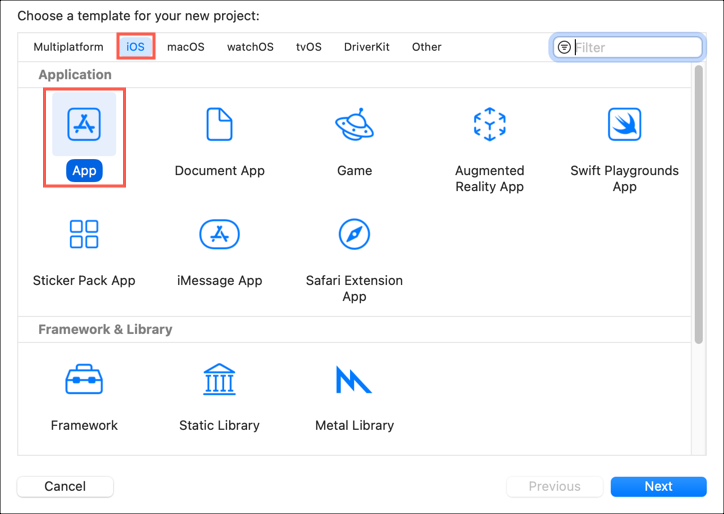
Choose the project template -
Set the project information as follows:
- Product Name: Simple-Video-Playback
- Team: none
The Team field is optional. If you want to distribute your app on the App Store, you will need to select a team that you belong to through the Apple Developer Program. The team name is required for code signing. In this example, we'll select none.
- Organization Name: your company name
- Organization Identifier: com.example-company
This makes the product name unique for the app store. - Interface: Storyboard In this example, we are using the storyboard interface.
- Language: Swift
Click Next.
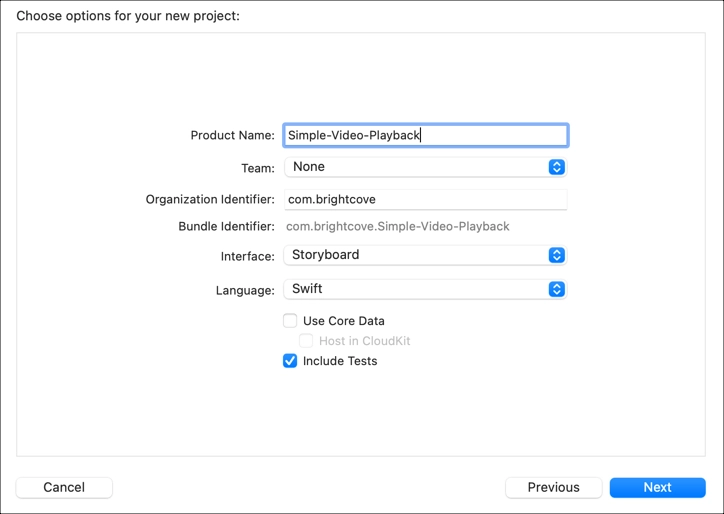
Add project information -
Choose the location where you want to save your project and create it.
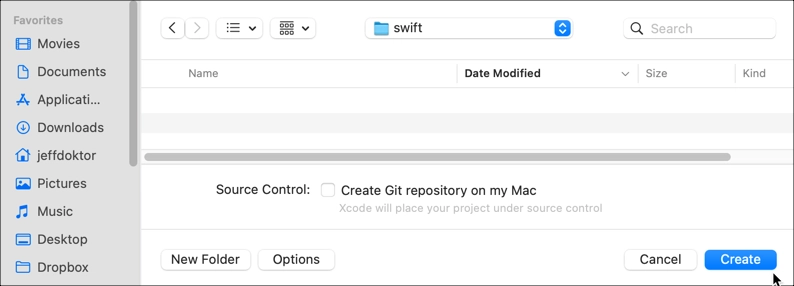
Save project - Now close the project (yes, close it — this is important!)
Add the SDK and its dependencies to your project
The easiest way to add the SDK and its dependencies to your project is to use CocoaPods.
CocoaPods is a dependency manager that adds libraries to your project. It is not required, but makes installation easier. To install CocoaPods, see the instructions on the CocoaPods site.
-
In your project folder, create a plain text file called Podfile (no file extension).
-
Using a text editor, add the following lines of code to the Podfile and save it. This code does the following:
- Line 1: Points to the GitHub location for the CocoaPods pod specs
- Line 2: Points to the GitHub location for the Brightcove pod specs
- Line 4: Defines the iOS platform version
- Line 6: Sets Pods to use frameworks instead of static libraries
-
Lines 8-10: Install the Brightcove Native Player SDK
- For more information about managing dependencies, see the How To Manage Dependencies With CocoaPods article.
source 'https://github.com/CocoaPods/Specs.git' source 'https://github.com/brightcove/BrightcoveSpecs.git' platform :ios, '16.0' use_frameworks! target 'Simple-Video-Playback' do pod 'Brightcove-Player-Core/XCFramework' end -
Open a Terminal session and navigate to your Simple-Video-Playback Xcode project folder.

Terminal session -
In the Terminal session, type the command
pod installand press Return to run the it.
If CocoaPods can not find a compatible version for the pod, or it is not the latest version, try running the following in the Terminal app:
pod updateYou should see a series of messages in the terminal indicating that the Brightcove Player SDK has been added to your project.
-
The
pod installcommand creates the.xcworkspacefile for your project.Notice the last line, which is important — from this point on, you must do the following:
- Open the Simple-Video-Playback.xcworkspace file in Xcode
- Do not use the Simple-Video-Playback.xcodeproj file

Workspace
Code the video app
Create the code for a simple video playback app.
- In Xcode, open the Simple-Video-Playback.xcworkspace file.
Set the audio behavior for the app
The audio session handles audio behavior at the app level. Learn more about the AVAudioSession class.
For this sample, we will use the playback category. This plays audio even when the screen is locked and with the Ring/Silent switch set to silent. Since we are playing video, we will use the moviePlayback mode. To keep it simple, we will put this code in the App Delegate.
-
In your project, open the App Delegate file (AppDelegate.swift).
-
In the
didFinishLaunchingWithOptionsfunction, add code to set the audio session category. Make sure you import theAVFoundationframework.-
We need the code below in order to ensure that audio plays back when we expect it to. For example, without setting this code, we won't hear the video when the mute switch is on.
// // AppDelegate.swift // Simple-Video-Playback // // Copyright © Brightcove. All rights reserved. // import UIKit import AVFoundation @UIApplicationMain class AppDelegate: UIResponder, UIApplicationDelegate { var window: UIWindow? func application(_ application: UIApplication, didFinishLaunchingWithOptions launchOptions: [UIApplicationLaunchOptionsKey: Any]?) -> Bool { // Override point for customization after application launch. var categoryError :NSError? var success: Bool do { try AVAudioSession.sharedInstance().setCategory(.playback, mode: .moviePlayback, options: .duckOthers) success = true } catch let error as NSError { categoryError = error success = false } if !success { print("AppDelegate Debug - Error setting AVAudioSession category. Because of this, there may be no sound. \(categoryError!)") } return true } func applicationWillResignActive(_ application: UIApplication) { // Sent when the application is about to move from active to inactive state. This can occur for certain types of temporary interruptions (such as an incoming phone call or SMS message) or when the user quits the application and it begins the transition to the background state. // Use this method to pause ongoing tasks, disable timers, and invalidate graphics rendering callbacks. Games should use this method to pause the game. } func applicationDidEnterBackground(_ application: UIApplication) { // Use this method to release shared resources, save user data, invalidate timers, and store enough application state information to restore your application to its current state in case it is terminated later. // If your application supports background execution, this method is called instead of applicationWillTerminate: when the user quits. } func applicationWillEnterForeground(_ application: UIApplication) { // Called as part of the transition from the background to the active state; here you can undo many of the changes made on entering the background. } func applicationDidBecomeActive(_ application: UIApplication) { // Restart any tasks that were paused (or not yet started) while the application was inactive. If the application was previously in the background, optionally refresh the user interface. } func applicationWillTerminate(_ application: UIApplication) { // Called when the application is about to terminate. Save data if appropriate. See also applicationDidEnterBackground:. } } -
Build the View Controller
Update the View Controller class to play a video from the Brightcove catalog service.
-
In your project, open the View Controller file (ViewController.swift).
Import the Native SDK
Although the Brightcove Native Player SDK for iOS is written in Objective-C, we can simply import the framework modules into our Swift project.
-
Below the existing
importdirective, add the following to import the Brightcove Native Player SDK:import BrightcovePlayerSDK
Customize the project with your values
Add values to access your Video Cloud account.
This example plays a video returned from the Brightcove Playback API, which is the latest and recommended API to retrieve content from your Video Cloud library. If you are not familiar with Policy Keys, see the Policy API Overview.
-
Below the
importdirectives, add your own values for the following:- Line 12: Defines your Brightcove Playback API Policy Key
- Line 13: Defines your Video Cloud Account ID
-
Line 14: Defines your Video Cloud Video ID
// ** Customize these values with your own account information ** let kViewControllerPlaybackServicePolicyKey = "your policy key" let kViewControllerAccountID = "your account id" let kViewControllerVideoID = "your video id"
Set the class delegate
This allows your app to listen and respond to video playback events and player control events.
-
Update the View Controller class as follows:
class ViewController: UIViewController, BCOVPlaybackControllerDelegate {
Declare constants and set the view
-
In the
ViewControllerclass, add the following :- Line 16: Initializes a shared manager. The
BCOVPlayerSDKManagerclass is a singleton that allows you to create other objects in the SDK ecosystem. - Line 17: Defines a constant, which initializes the Brightcove playback service with your Account ID and Policy Key. The
BCOVPlaybackServiceclass provides asynchronous methods for retrieving data from the Playback API. - Line 18: Defines a constant for the playback controller. The
BCOVPlaybackControllerhas methods to control playback functionality. -
Line 19: Defines a variable for the view.
class ViewController: UIViewController, BCOVPlaybackControllerDelegate { let sharedSDKManager = BCOVPlayerSDKManager.shared() let playbackService = BCOVPlaybackService(accountId: kViewControllerAccountID, policyKey: kViewControllerPlaybackServicePolicyKey) let playbackController :BCOVPlaybackController @IBOutlet weak var videoContainerView: UIView! - Line 16: Initializes a shared manager. The
Create an init function
- Below the code in the previous step, create an
init()function as follows:- Line 23: Uses the shared manager to create a playback controller.
-
Line 27: Optional: Sends your Video Cloud Account ID to analytics. This is only needed if you override the
BCOVVideoclass or do not use the Brightcove Playback service or catalog. -
Lines 29-31: set the delegate and turn on the auto-advance and autoplay features.
required init?(coder aDecoder: NSCoder) { playbackController = (sharedSDKManager?.createPlaybackController())! super.init(coder: aDecoder) playbackController.analytics.account = kViewControllerAccountID // Optional playbackController.delegate = self playbackController.isAutoAdvance = true playbackController.isAutoPlay = true }
Configure the player
-
In the
viewDidLoad()function, add the following:- Line 39: Create and set the Brightcove player controls, using the standard VOD layout.
- Line 44: Adds the player view as a subview of the main view.
- Line 45: Turn off auto-resizing mask.
- Lines 46-51: Use Auto Layout to define dynamic contraints for the player view.
- Line 54: Associate the player view with the playback controller.
-
Line 56: Calls the
requestContentFromPlaybackServicefunction, which we will define in the next step.
override func viewDidLoad() { super.viewDidLoad() // Do any additional setup after loading the view, typically from a nib. // Set up our player view. Create with a standard VOD layout. guard let playerView = BCOVPUIPlayerView(playbackController: self.playbackController, options: nil, controlsView: BCOVPUIBasicControlView.withVODLayout()) else { return } // Install in the container view and match its size. self.videoContainerView.addSubview(playerView) playerView.translatesAutoresizingMaskIntoConstraints = false NSLayoutConstraint.activate([ playerView.topAnchor.constraint(equalTo: self.videoContainerView.topAnchor), playerView.rightAnchor.constraint(equalTo: self.videoContainerView.rightAnchor), playerView.leftAnchor.constraint(equalTo: self.videoContainerView.leftAnchor), playerView.bottomAnchor.constraint(equalTo: self.videoContainerView.bottomAnchor) ]) // Associate the playerView with the playback controller. playerView.playbackController = playbackController requestContentFromPlaybackService() }
Request content from the Brightcove library
In order to play back video content, you will request a playlist from the catalog service
-
Below the
viewDidLoad()function, create a function namedrequestContentFromPlaybackService()as follows:- Line 60: Returns a video object from the Playback API based on the given video id.
- Line 63: Adds the video to the playback controller.
-
Line 65: Writes an error message if a playlist is not returned.
func requestContentFromPlaybackService() { let configuration = [kBCOVPlaybackServiceConfigurationKeyAssetID:kViewControllerVideoID] playbackService?.findVideo(withConfiguration: configuration, queryParameters: nil, completion: { [weak self] (video: BCOVVideo?, jsonResponse: [AnyHashable: Any]?, error: Error?) in if let v = video { self?.playbackController.setVideos([v] as NSArray) } else { print("ViewController Debug - Error retrieving video: \(error?.localizedDescription ?? "unknown error")") } }) }
View the code
The View Controller is now complete. Here is the full code:
//
// ViewController.swift
// VideoCloudBasicPlayer
//
// Copyright © Brightcove, Inc. All rights reserved.
//
import UIKit
import BrightcovePlayerSDK
let kViewControllerPlaybackServicePolicyKey = "your policy key"
let kViewControllerAccountID = "your account id"
let kViewControllerVideoID = "your video id"
class ViewController: UIViewController, BCOVPlaybackControllerDelegate {
let sharedSDKManager = BCOVPlayerSDKManager.shared()
let playbackService = BCOVPlaybackService(accountId: kViewControllerAccountID, policyKey: kViewControllerPlaybackServicePolicyKey)
let playbackController :BCOVPlaybackController
@IBOutlet weak var videoContainerView: UIView!
required init?(coder aDecoder: NSCoder) {
playbackController = (sharedSDKManager?.createPlaybackController())!
super.init(coder: aDecoder)
playbackController.analytics.account = kViewControllerAccountID // Optional
playbackController.delegate = self
playbackController.isAutoAdvance = true
playbackController.isAutoPlay = true
}
override func viewDidLoad() {
super.viewDidLoad()
// Do any additional setup after loading the view, typically from a nib.
// Set up our player view. Create with a standard VOD layout.
guard let playerView = BCOVPUIPlayerView(playbackController: self.playbackController, options: nil, controlsView: BCOVPUIBasicControlView.withVODLayout()) else {
return
}
// Install in the container view and match its size.
self.videoContainerView.addSubview(playerView)
playerView.translatesAutoresizingMaskIntoConstraints = false
NSLayoutConstraint.activate([
playerView.topAnchor.constraint(equalTo: self.videoContainerView.topAnchor),
playerView.rightAnchor.constraint(equalTo: self.videoContainerView.rightAnchor),
playerView.leftAnchor.constraint(equalTo: self.videoContainerView.leftAnchor),
playerView.bottomAnchor.constraint(equalTo: self.videoContainerView.bottomAnchor)
])
// Associate the playerView with the playback controller.
playerView.playbackController = playbackController
requestContentFromPlaybackService()
}
func requestContentFromPlaybackService() {
let configuration = [kBCOVPlaybackServiceConfigurationKeyAssetID:kViewControllerVideoID]
playbackService?.findVideo(withConfiguration: configuration, queryParameters: nil, completion: { [weak self] (video: BCOVVideo?, jsonResponse: [AnyHashable: Any]?, error: Error?) in
if let v = video {
self?.playbackController.setVideos([v] as NSArray)
} else {
print("ViewController Debug - Error retrieving video: \(error?.localizedDescription ?? "unknown error")")
}
})
}
}
Import the Native SDK
Although the Brightcove Native Player SDK for iOS is written in Obj-C, we can simply import the framework modules into our Swift project.
-
Below the existing
importdirective, add the following to import the Brightcove Native Player SDK:import BrightcovePlayerSDK
Customize the project with your values
Set the value of your Account Id, which will be sent to Brightcove in a later step.
-
Below the
#importdirectives, add your own value for your Brightcove Account Id. This will be used to register your app with Brightcove.let kViewControllerAccountID = "your account id" // For Brightcove registration
Set the class delegates
This allows your app to listen and respond to video playback events and player control events.
-
Update the View Controller class as follows:
class ViewController: UIViewController, BCOVPlaybackControllerDelegate {
Declare constants and set the view
-
In the
ViewControllerclass, add the following :- Line 14: Initializes a shared manager. The
BCOVPlayerSDKManagerclass is a singleton that allows you to create other objects in the SDK ecosystem. - Line 15: Defines a constant for the playback controller. The
BCOVPlaybackControllerhas methods to control playback functionality. -
Line 16: Defines a variable for the view.
class ViewController: UIViewController, BCOVPlaybackControllerDelegate { let sharedSDKManager = BCOVPlayerSDKManager.shared() let playbackController :BCOVPlaybackController @IBOutlet weak var videoContainerView: UIView! - Line 14: Initializes a shared manager. The
Create an init function
- Below the code in the previous step, create an
init()function as follows:- Line 20: Uses the shared manager to create a playback controller.
-
Line 25: Sends your Video Cloud Publisher ID to Brightcove analytics to register your app.
-
Lines 28-30: Set the delegate and turns on the auto-advance and autoplay features.
required init?(coder aDecoder: NSCoder) { // Create the Brightcove playback controller playbackController = (sharedSDKManager?.createPlaybackController())! super.init(coder: aDecoder) // Register your app with Brightcove playbackController.analytics.account = kViewControllerAccountID // Configure the player playbackController.delegate = self playbackController.isAutoAdvance = true playbackController.isAutoPlay = true }
Configure the player
-
In the
viewDidLoad()function, add the following:- Lines 38-40: Create an array of video sources using url paths.
- Lines 43-45: Configures the playback controller's view.
- Line 48: Adds the player view as a subview of the main view.
- Line 49: Turn off auto-resizing mask.
- Lines 50-55: Use Auto Layout to define dynamic contraints for the player view.
- Line 58: Associates the player view with the playback controller.
- Line 61: Adds the video array to the controller's playback queue.
-
Line 62: Starts playback of the first video.
override func viewDidLoad() { super.viewDidLoad() // Do any additional setup after loading the view, typically from a nib. // Create an array of videos var videoArray = [AnyObject]() videoArray = [videoWithURL(url: NSURL(string: "https://solutions.brightcove.com/bcls/assets/videos/Great_Horned_Owl.mp4")!), videoWithURL(url: NSURL(string: "https://solutions.brightcove.com/bcls/assets/videos/Great_Blue_Heron.mp4")!)] // Set up the player view with a standard VOD layout. guard let playerView = BCOVPUIPlayerView(playbackController: self.playbackController, options: nil, controlsView: BCOVPUIBasicControlView.withVODLayout()) else { return } // Install the container view and match its size. self.videoContainerView.addSubview(playerView) playerView.translatesAutoresizingMaskIntoConstraints = false NSLayoutConstraint.activate([ playerView.topAnchor.constraint(equalTo: self.videoContainerView.topAnchor), playerView.rightAnchor.constraint(equalTo: self.videoContainerView.rightAnchor), playerView.leftAnchor.constraint(equalTo: self.videoContainerView.leftAnchor), playerView.bottomAnchor.constraint(equalTo: self.videoContainerView.bottomAnchor) ]) // Associate the playerView with the playback controller. playerView.playbackController = playbackController // Load the video array into the player and start video playback playbackController.setVideos(videoArray as NSArray) playbackController.play(); }
Set the delivery method for video sources
-
Below the
viewDidLoad()function, create a function that sets the delivery method forBCOVSourcesthat belong to a video.func videoWithURL(url: NSURL) -> BCOVVideo { // Set the delivery method for BCOVSources that belong to a video let source:BCOVSource = BCOVSource(url: url as URL, deliveryMethod: kBCOVSourceDeliveryHLS, properties: nil) let video = BCOVVideo.init(source: source, cuePoints: BCOVCuePointCollection.init(array: []), properties: [NSObject:AnyObject]()) return video! }
View the code
The View Controller is now complete. Here is the full code:
//
// ViewController.swift
// Simple-Video-Playback for Brightcove Player Customers
//
// Copyright © Brightcove. All rights reserved.
//
import UIKit
import BrightcovePlayerSDK
let kViewControllerAccountID = "your account id" // For Brightcove registration
class ViewController: UIViewController, BCOVPlaybackControllerDelegate {
let sharedSDKManager = BCOVPlayerSDKManager.shared()
let playbackController :BCOVPlaybackController
@IBOutlet weak var videoContainerView: UIView!
required init?(coder aDecoder: NSCoder) {
// Create the Brightcove playback controller
playbackController = (sharedSDKManager?.createPlaybackController())!
super.init(coder: aDecoder)
// Register your app with Brightcove
playbackController.analytics.account = kViewControllerAccountID
// Configure the player
playbackController.delegate = self
playbackController.isAutoAdvance = true
playbackController.isAutoPlay = true
}
override func viewDidLoad() {
super.viewDidLoad()
// Do any additional setup after loading the view, typically from a nib.
// Create an array of videos
var videoArray = [AnyObject]()
videoArray = [videoWithURL(url: NSURL(string: "https://solutions.brightcove.com/bcls/assets/videos/Great_Horned_Owl.mp4")!),
videoWithURL(url: NSURL(string: "https://solutions.brightcove.com/bcls/assets/videos/Great_Blue_Heron.mp4")!)]
// Set up the player view with a standard VOD layout.
guard let playerView = BCOVPUIPlayerView(playbackController: self.playbackController, options: nil, controlsView: BCOVPUIBasicControlView.withVODLayout()) else {
return
}
// Install in the container view and match its size.
self.videoContainerView.addSubview(playerView)
playerView.translatesAutoresizingMaskIntoConstraints = false
NSLayoutConstraint.activate([
playerView.topAnchor.constraint(equalTo: self.videoContainerView.topAnchor),
playerView.rightAnchor.constraint(equalTo: self.videoContainerView.rightAnchor),
playerView.leftAnchor.constraint(equalTo: self.videoContainerView.leftAnchor),
playerView.bottomAnchor.constraint(equalTo: self.videoContainerView.bottomAnchor)
])
// Associate the playerView with the playback controller.
playerView.playbackController = playbackController
// Load the video array into the player and start video playback
playbackController.setVideos(videoArray as NSArray)
playbackController.play();
}
func videoWithURL(url: NSURL) -> BCOVVideo {
// Set the delivery method for BCOVSources that belong to a video
let source:BCOVSource = BCOVSource(url: url as URL, deliveryMethod: kBCOVSourceDeliveryHLS, properties: nil)
let video = BCOVVideo.init(source: source, cuePoints: BCOVCuePointCollection.init(array: []), properties: [NSObject:AnyObject]())
return video!
}
}
Connect the storyboard view
Connect the Main.storyboard view with the videoContainerView property.
-
In the Xcode, open the
Main.storyboardfile. -
In the companion view, expand the View Controller Scene and then the View Controller menu to expose the View object.
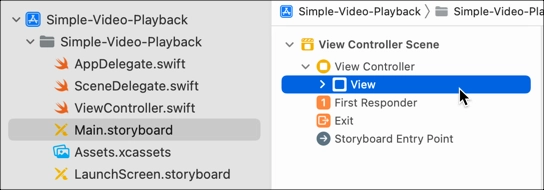
Storyboard view -
Click Add Editor on Right, and open the
ViewController.swiftfile.
Add editor -
Select the open circle next to the
@IBOutletforvideoContainerView, and drag it to the View object to connect these components.
Connect the view
Manage Media Security
App Transport Security (ATS) enforces secure connections between your app and web services. With Apple's release of the iOS 9 SDK, a new feature called App Transport Security (ATS) was added.
-
One of the following situations will apply to your app:
-
By default the Brightcove Native SDK for iOS uses a source selection policy to choose HTTPS over HTTP sources, so you can build your apps with ATS enabled.
That's it, you are ready to run your app.
-
If your remote assets use HTTPS instead of HTTP sources, then you can build your apps with ATS enabled.
That's it, you are ready to run your app.
-
If you are using HTTP sources or have other HTTP calls in your app, you may encounter the following error message:
App Transport Security has blocked a cleartext HTTP (http://) resource load since it is insecure. Temporary exceptions can be configured via your app's Info.plist file.This means that ATS is enabled, but your system is not configured to meet the ATS requirements. To fix this situation, see the Working with App Transport Security (ATS) document.
-
Run the app
The app is ready to build and run on an iPhone, iPad or the iOS Simulator. You should be able to play the videos from your playlist.
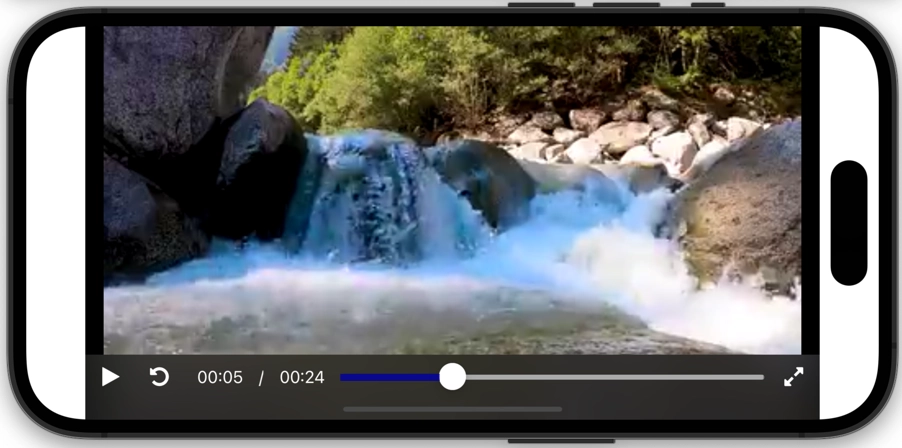
The app is ready to build and run on an iPhone, iPad or the iOS Simulator. You should be able to play the videos defined in your array.
